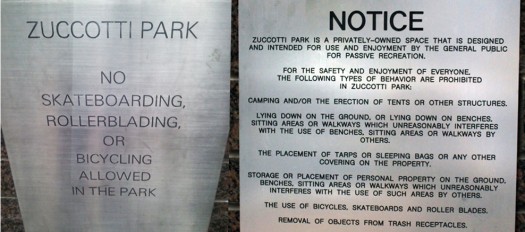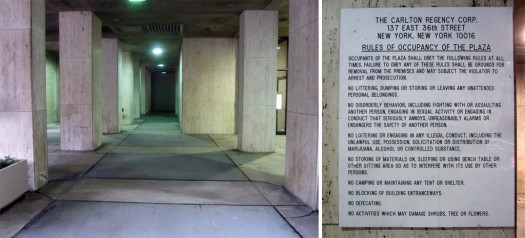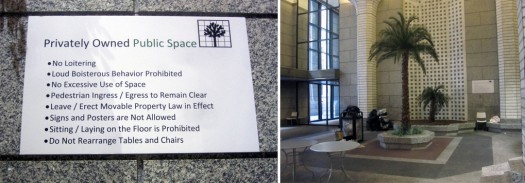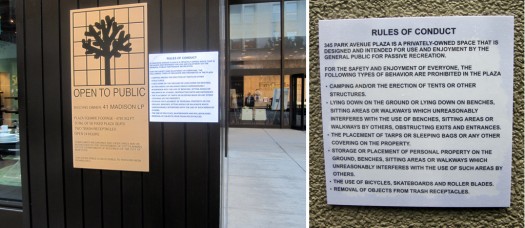
We are celebrating 15 years — and counting — of stories that are deeply researched and deeply felt, that build a historical record of what the city has been.
We are celebrating 15 years — and counting — of stories that are deeply researched and deeply felt, that build a historical record of what the city has been.
The establishment of a protest camp at Zuccotti Park in Lower Manhattan, the foundational act of Occupy Wall Street, transformed the concept of privately owned public space (POPS) from a poorly understood zoning incentive into a household word, and a provocative metaphor for the encroachment of corporate interests into civic life. A manicured open space originally created by US Steel to negotiate a height bonus for an adjacent building, this was no Tahrir Square. But its status as the visible base of a worldwide movement did start a citywide conversation about the meaning, regulation and instrumentality of public space. That conversation has manifested itself in events, articles and even promenade proposals. And it’s far from over. This week, urban planner and designer Douglas Woodward revisits this conversation by calling specific attention to the Rules of Conduct signs whose increasingly enumerated prohibitions demonstrate the ongoing challenges of balancing competing interests in the private provision of public goods. –C. S.
READING PRIVATELY OWNED PUBLIC SPACE
The recent occupation and re-occupation of Zuccotti Park in Lower Manhattan by the Occupy Wall Street protesters provoked an accompanying frenzy of classificatory activity around the terms “public space” and “privately owned public space” and the behaviors that are encouraged, allowed or prohibited in these spaces. “Tell me how you classify,” writes Alain Robbe-Grillet quoting Roland Barthes paraphrasing Brillat-Savarin, “and I’ll tell you who you are.”[1] And, we might now add, whom you do not want using your public space.[2]
According to the canonical text on privately owned public space, or POPS, Privately Owned Public Space, The New York City Experience (2000) — co-authored by Jerold Kayden, professor of urban planning and design at Harvard and the leading expert on the subject, the Department of City Planning and the Municipal Art Society — 41% of the 503 existing POPS were “of marginal utility.”[3] In the twelve years since that study was published, the worst of these spaces have only gotten worse, the percentage of marginal spaces has increased, and very few new, outstanding or rehabilitated spaces have been built.
The activities owners allow or prohibit in a POPS constitute one of the key indicators of its health and vitality. And prohibitions posted on POPS’ Rules of Conduct signs range from simple rules like “No Smoking” to exhaustive catalogues that sound more like the Abominations of Leviticus than descriptions of expected behavior in public space. Therefore, a close reading of a space’s posted Rules of Conduct can suggest how well or poorly a space functions. I might take this argument a step further: without ever visiting a particular POPS, a shrewd observer could simply analyze its Rules of Conduct sign in order to divine its character, location, design concept or parti, and current condition.
The City’s recent public plaza zoning, enacted in 2007, contains the following provision governing the design and content of Rules of Conduct signs (italics denote defined terms in the zoning):
[A “Rule of Conduct”] sign shall not prohibit behaviors that are consistent with the normal public use of the public plaza such as lingering, eating, drinking of non-alcoholic beverages or gathering in small groups. No behaviors, actions, or items may be listed on such sign that are otherwise illegal or prohibited by municipal, State, or Federal laws.[4]
In general, Rules of Conduct signs in POPS specify prohibitions in four categories: movement (“no skateboarding”); sound (“no radio-playing”); illegal activity (“no distribution of controlled substances”); and use of space (“no sleeping”). In the post-Zuccotti-Park era, however, an increasing number of owners of POPS have begun posting regulations that essentially limit all permitted activities to passive uses.
Little thought was given to what public space meant… the simple provision of space itself was considered an unalloyed good.Even before Zuccotti Park, this desire for passivity was a recurring subtext in Rules of Conduct signs. The posted rules for many POPS are coded with an underlying fear of activity, of users whose impulses, if unchecked, are to gamble, deal drugs, play loud music, engage in public sex, and otherwise misbehave and disturb the blessèd calm of public space. These signs express a view of public space as fundamentally inert, of public space as a refuge from urban life rather than as a place of engagement within it.
VISITING ZUCCOTTI (BEFORE AND AFTER)
The regulations posted on the Zuccotti Park Rules of Conduct sign were the subject of a recent lawsuit by the Occupy Wall Street (“OWS”) protesters. New York State Supreme Court Justice Michael Stallman’s decision ratified Mayor Michael M. Bloomberg’s expulsion of the protesters from the park, at least to the extent that they can no longer colonize the space with tents and other structures with impunity. The space has returned (mostly) to its spinsterish previous life as a large, empty plaza. In his brief decision denying their motion for a full restoration of the encampment, Judge Stallman held that the protesters had “not demonstrated that the rules adopted by the owners of the property… are not reasonable time, place, and manner restrictions permitted under the First Amendment.”[5]
In an amicus brief recently filed by the City opposing a new suit brought by the NYCLU seeking to vacate charges of trespass, disorderly conduct, and obstruction of governmental administration against an OWS protestor, the City writes: “Many of the NYCLU’s assertions misconstrue the nature of POPS in general, the ability of POPS owners to prescribe reasonable rules of conduct for those using the space and the particular provisions of the Zoning Resolution applicable to Zuccotti Park.”[6] But the regulations governing POPS and Rules of Conduct are not nearly as clear as the City would have the court believe.
Kayden, et al., cite the origin of POPS in the 1958 Voorhees draft zoning resolution, the basis for the City’s 1961 revisions of the 1916 zoning, which matter-of-factly recites the rationale for incentivizing public space through zoning: “[i]n order to bring more light and air into the streets surrounded by tall buildings, as well as to create more usable open space, a bonus device has been established to encourage the setting back of buildings from the street line.”[7] The original bonus dealt only with plazas in front of the building, and can be traced to the 1961 drafters’ reliance on the Corbusian model of the “tower in the park,” which later so vexed the contextualists and their streetwall model.
A problem that has come down to us through the genesis of the regulatory history of POPS is that, until relatively recently, little thought has been given to what public space means in the context of private ownership: the simple provision of space itself was considered an unalloyed good.

Left: Original Rules of Conduct sign for Zuccotti Park | Right: Post-occupation rules for Zuccotti Park
The rules the Supreme Court decision deals with were promulgated by Brookfield Properties, the owners of the POPS, after the occupation was already in full swing. The pre-occupation rules for Zuccotti Park — named for John E. Zuccotti, the Chairman of Brookfield, who chaired the City Planning Commission when the first major revision of zoning rules requiring descriptive signage in POPS was undertaken — were much milder than the new ones, prohibiting only active “nuisance” activities.
The revised, post-occupation Zuccotti Park rules upheld in the Supreme Court decision specifically cited its intended use for “passive recreation,” among a host of other very specific prohibitions.
The suit illustrated how amorphous the regulations are that control POPS. According to the City’s own analysis, the zoning “never expressly defines what limits the owner may impose, if any, upon… public use” in POPS.[8]
EXAMINING THE SIGNS
Even the best spaces in the inventory, like 590 Atrium, the POPS in the former IBM building, tend to err on the side of inclusiveness when deciding what activities should be banned, listing multiple, seemingly arbitrary collections of prohibited behaviors.
Despite its stern phraseology and Teutonic capitalization, the 590 posting is far less threatening than many POPS signs. But it also offers a few key indicators of how building owners (and their legal departments) view appropriate behavior in public space as essentially one of “quiet enjoyment.”

Left: The Carlton Regency North POPS, empty even of required amenities | Right: Carlton Regency North Rules of Conduct sign
Some Rules of Conduct signs imply a harrowing past for a particular space. One Midtown POPS has posted a Rules of Conduct sign that prohibits “fighting, assaulting another person, engaging in sexual activity,” and contains a “no defecating” clause. It seems to me that an explicit rule against defecation, suggesting that without the prohibition a user might think it permissible, would only seem necessary in an extremely poorly designed space. And, indeed, the Carlton Regency North at the southeast corner of East 37th Street and Lexington Avenue is one of the worst-designed spaces in the entire POPS inventory, to the shame of its designer (listed in the City Planning POPS database as Harry F. Green) and to the building that “maintains” it.
Some other troubled spaces, like the Penn Plaza complex, which contains seven large POPS, gang-post several signs together as newer behavioral issues emerge to be confronted. The through-block space off 34th Street contains a gamut of users at lunchtime, but at off-times during the day in good weather, when local workers are at their desks, the space is filled with street people. Lest their enjoyment of the sun and the planter seating become troublesome to Vornado, the owner of the POPS at Penn Plaza and around Penn Station, the company has also posted numerous signs to remind visitors that the space is closed at night, and that the rules prohibit sleeping, panhandling and loitering. Also prohibited are more actively problematic behaviors like rollerblading, skateboarding, biking and littering, which required the addition of a footnote of a sign below the larger one.
The POPS at 60 Wall Street, on the ground floor of the Deutsche Bank building, is a vast, postmodern, vaguely orientalist confection designed by Kevin Roche, complete with palm trees and originally a water feature along the western wall. After the evacuation of Zuccotti Park, the space played host to “working groups” of OWS protesters who offered training and workshops in subjects like “Nonviolent Communication and Compassionate Communication.”
After the diaspora from Zuccotti Park, Deutsche Bank posted six large signs (non-conforming under the new zoning rules), laying out a new program of prohibitions, which included a ban on “signs and posters,” a provision that seemed aimed at the OWS groups now using the atrium. After the rule was challenged on First Amendment grounds, Deutsche Bank issued a clarification maintaining that the rule was intended to apply only to affixing signs to walls and other parts of the premises and was not intended to limit the carrying or display of signs by protesters.[9]

Left: New Rules of Conduct signs at 60 Wall Street | Right: The western half of the space, with homeless concentration
Almost since its opening, 60 Wall Street has been the cold-weather refuge for a large homeless population. But because the space is so vast — two sections of tables and chairs separated by a wide central circulation aisle, and even a subway entrance to the IRT Wall Street station — the homeless users and local Wall Street workers co-exist without direct interaction. The homeless stick mainly to the western half of the space along the wall and the Wall Street crowd occupy the tables on the eastern edge, next to a row of small shops. 60 Wall Street illustrates an important, but largely unacknowledged, function of some of the larger spaces in the POPS inventory: that of providing warmth, shelter and some degree of bodily comfort (there are also two public restrooms in the space) to a population that would otherwise be out on the street, unprotected during the winter months. The responsibility of POPS owners to accommodate all users is well-documented; as City Planning has itself made clear, exclusion by owners of classes of “undesirable” persons for reasons other than improper conduct is forbidden.[10]
Despite all the rule-making, there is still no clear guide as to what constitutes proper behavior in a POPS, or exactly what kind of activities property owners can control. The spaces themselves offer a bewildering array of definitions.
The POPS at the old Whitney Sculpture Court space across from Grand Central, which lost its art-related use in 1997, has a lengthy list of prohibitions, including “no controlled substances” in addition to the standard no gambling and no drinking clauses, and a somewhat ambiguous prohibition against “conduct which is inconsistent with a Sculpture Gallery.” To begin with, the sculpture gallery has been out of existence for fifteen years, so what was contemplated by that rule? Too-fervent criticism of Modular Constructivism? It is impossible to know what the drafters of the Rules of Conduct signs were after precisely, except the legal protections afforded by prohibitory repletion in case someone needs to be removed from the space and its owners defended from legal action.
In the shadow of the occupation of Zuccotti Park, new signs with deeper prohibitions have begun appearing. The new signs, in addition to the standard “no skateboarding” sorts of rules, now all contain variants of the revised Zuccotti Park restrictions, specifically what we might think of as protester-unfriendly prohibitions:
No camping or erection of tents
No lying down on the ground or on benches
No tarps or sleeping bags
No storage of personal property
No obstruction of paths or entrances
SEEKING CLARITY
The Zuccotti Park occupation has changed the way owners of POPS have thought about regulating behavior in their spaces. However restrictive some Rules of Conduct signs may have seemed before Zuccotti, they were also so vague and unsystematic as to be unenforceable. For example, the zoning specifically encourages “lingering” in spaces; but many Rules of Conduct signs ban “loitering.” How is the line between the two determined? The new rules, by contrast, are clear and unambiguous: no camping, no tents, no occupation.
Since the new “post-Zuccotti” rules have now been tested by at least one court and found to be “reasonable time, place and manner restrictions” permitted by the First Amendment, their adoption by many more owners is a certainty. And while City Planning has managed to stay mostly above the fray in the battle over the use of Zuccotti Park, which has been stage-managed by the Mayor’s Office, groups like the Real Estate Board of New York (REBNY) have started to apply pressure to allow nighttime closings for all spaces similar to the closing times for New York City’s public parks in order to define a set of clear, enforceable rules, a zoning change that would need to go through the City Planning Commission.

Left: 41 Madison Avenue with newly posted anti-camping regulations based on the Zuccotti Park rules | Right: 345 Park Avenue’s “post-Zuccotti” rules
The current planning department director and Chair of the Planning Commission, Amanda Burden, is a protégée of William Holly Whyte, the great theorist and healer of urban public spaces. She recently directed the department to restructure and tighten the zoning rules governing public plazas based on Whyte’s observations of and recommendations for best practices in public spaces, especially with regard to seating. Because of her decades-long involvement with and love of public space, her administration has been marked by a brilliantly close reading [11] of these spaces. However, the revised rules are prospective, and with very few new spaces getting built, they are little-used. Existing spaces are not helped at all by the new regulatory framework unless they are rehabilitated.
At the end of March, both City Council Speaker Christine Quinn and the Mayor went on the record to support the idea that POPS should obey the Rules of Conduct for New York City parks, which include, for most parks, nighttime closings and time-tested regulations against both commercial and private activities, including camping. The City’s interest in defining POPS activities by a known universe of regulations, along the lines of the rules for public parks, is clear. Parks have evolved a clear separation of public uses from private intrusions like commercial activities in part through licensing, which in turn supports the parks through the fees collected, and requirements for City permits for protests or parades. The situation of hybrid spaces like POPS is less clear and thus explains the City’s enthusiasm for applying the parks rules to clarify and reinforce its rights in managing what happens in the spaces.
In the post-Zuccotti Park era, an increasing number of POPS owners have begun posting regulations that essentially limit all permitted activities to passive uses. In part, the confusion about what these spaces are for derives from the term “public space” itself, and even more from the hybrid condition known as “privately owned public space.” The critic Rowan Moore has pointed out the “insubstantiality” of the very concept of public space, evident in the phrase itself, a criticism voiced by Marc Augé and other scholars about the other common generic identifier, “green space.” Both are abstractions that “corrode” (Augé’s term) the experience of actual places. “No one says, ‘I am going to the public space this afternoon,’”[12] Moore writes, identifying the central lack of definability in the image-repertoire of the concept.
But definitional clarity alone will not reconcile competing interests in POPS. While regulations and enforcement need to address the assumption among property owners that people will not behave appropriately unless sternly admonished about what they can and cannot do in a space, the fundamental disconnect between the rights of property owners to control activities within POPS and the rights of the public to protest and even occupy these spaces remains muddled and perhaps ultimately irresolvable.
Any successful set of rules will need to balance free speech with property rights in the wake of the conflicts at Zuccotti Park, but simply regularizing the array of private rules of conduct in POPS, with their quirky, restrictive and sometimes incomprehensible provisions, will be critical in helping to frame the more important debate about rights and restrictions.
“The design of any good city demands a theory of the desirable,” Michael Sorkin wrote in the afterword to his ideal zoning resolution, Local Code.[13] The same is true at the smaller scale of the 517 POPS in the City’s inventory of public space, but the problem is in defining what exactly that unified field theory of the desirable should encompass.
One way of expressing the vision for a particular space is through the rules that govern engagement and interaction within it. These are sometimes explicit (as in the case of POPS), but sometimes expected limits to behavior are expressed in a subtler way, internalized through our daily experience of the urban, public realm. The goal for POPS should be to develop a framework of rules that expresses the freedom of public spaces as long as certain common sense limits are observed about the rights of others. Such a framework is not best represented by Rules of Conduct that limit and hector the user, but rather a set of regulations that provide a sense of the fitness of all activities that do not harm others. A thought experiment: imagine that Rules of Conduct signs tell you nothing about a public space except that it embodies a potential for enjoyment, and that you have to experience it directly to understand and appreciate its particular excellence.
For more information or to get involved in advocacy efforts surrounding POPS, stay tuned for updates about a newly forged collaboration between Advocates for Privately Owned Public Space, a group founded by Jerold Kayden, and the Municipal Art Society. A committee (currently in formation), called APOPS@MAS, will examine the rules for POPS and suggest improvements, an effort that could be the beginning of a useful discussion among stakeholders about the future of public space in the private realm.
[1] Robbe-Grillet, Alain. Ghosts in the Mirror, Grove and Weidenfield (New York, 1988), p. 42.
[2] For an account of the Zuccotti Park occupation and how it relates to the hybrid public/private spaces created by zoning and known as POPS, see Jerold S. Kayden, “Meet Me at the Plaza,” Op-Ed, New York “Times,”October 20, 2011, http://www.nytimes.com/2011/10/20/opinion/zuccotti-park-and-the-private-plaza-problem.html.
[3] As cited on the City Planning website: http://www.nyc.gov/html/dcp/html/priv/priv.shtml
[4] NYC Zoning Resolution, §37-752, “Prohibition signs”
[5] https://www.documentcloud.org/documents/266875-judge-rules-in-favor-of-city.html
[6] http://blogs.villagevoice.com/runninscared/2012/03/as_ows_reenergi.php
[7] VoorheesWalker Smith & Smith, Zoning New York City: A Proposal for a Zoning Resolution for the City of New York (August, 1958), p. x.
[8] Kayden, Jerold S., New York City Department of City Planning, Municipal Art Society, Privately Owned Public Space, The New York City Experience (New York: John Wiley and Sons, 2000), p. 38. Hereafter cited as “POPS NYC.”
[9] http://cityroom.blogs.nytimes.com/2011/12/22/signs-may-be-allowed-into-public-atrium-used-by-protesters/?ref=nyregion
[10] There is a thorough discussion of this issue in “POPS NYC,” pp. 147-8.
[11] For example, the analysis of riser/tread relationships in the public plaza zoning, which was the result of careful study of dozens of existing examples. Other new rules were based on extensive analysis of plaza design and best practices around the world. See Primer on Plazas, http://www.nyc.gov/html/dcp/html/pops/pops.shtml.
[12] Williams, Rowan, “Notes on Public Space,” from Open: New Designs for Public Space, ed. Raymond W. Gastil and Zoë Ryan, (New York: Van Alen Institute, 2004), p. 116
[13] Sorkin, Michael. Local Code: The Constitution of a City at 42º N Latitude, (New York: Princeton Architectural Press, 2003), p.127.
The views expressed here are those of the authors only and do not reflect the position of The Architectural League of New York.
Comments